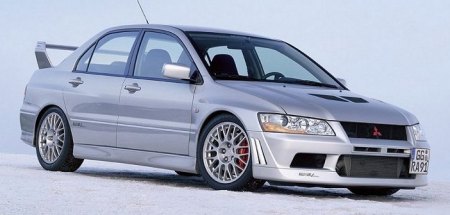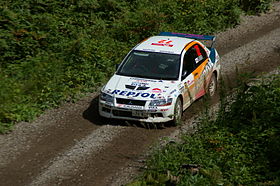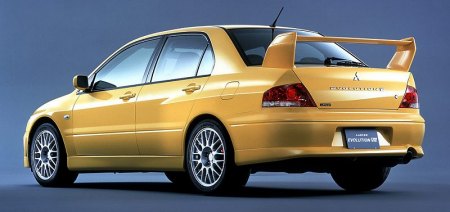The introduction of the Evolution VII also marked the first time an automatic drivetrain was included within the model lineup—the GT-A. Seen as the 'gentleman's express' version of the visually similar VII GSR and the RS2, the GT-A model was only produced in 2002 and had the following distinguishing interior and exterior specification: GT-A-only diamond cut finish 17-inch (430 mm) alloy wheels, clear rear light lenses and all-in-one style front headlights (later used on the Evolution VIII). The GT-A had the option of either no spoiler, the short spoiler (as per the Lancer Cedia; and later used on the Evolution VIII 260) or the thunderspoiler as used on the standard Evolution VII models. The most distinguishing feature was a smooth bonnet with no air-grills on it at all and the revised front bumper. Although offering inferior cooling capabilities, the bonnet was designed to give a cleaner line through the air with less air resistance at motorway speeds.
Interior could be specified with factory options of a deluxe velour interior, full leather or the Recaro sports seats. The GT-A interior was different in that it had chromed door handles, a different instrument panel (to show the gear selection) and chrome edged bezels around the speedo and tach. The GT-A also had additional sound deadening installed from the factory and the engine manifold and downpipe had been engineered to be quieter.
The 5-speed automatic gearbox had what Mitsubishi called "fuzzy logic", which meant that the car would learn what the driver's driving characteristics were like and would adapt the gear change timings and kick down reactions accordingly. The gears could be manually selected as with most Tiptronics via steering wheel + and – buttons (a pair both sides) or via selecting the tiptronic gate with the gear lever. Power was down a little from the standard manual cars with 272 PS (200 kW; 268 hp). The GT-A gearbox did not appear again in the Evolution VIII but has been installed in the estate version of the Evolution IX Wagon. It was replaced by the Twin Clutch SST gearbox since the introduction of Evolution X.

The Evo VII that arrived in Feb 2001 switched to the new generation Lancer Cedia platform, whose wheelbase grew by 115 mm to 2625 mm, actually longer than the original Galant VR-4! It was also considerably longer and taller than the old car. Even with extensive weight reduction, the car still carried 40 kg more than before. On the positive side, the new body shell with extra spot welds displayed 50 percent higher torsional rigidity. Wider front track and more suspension travel benefited handling. The 4G63 engine received minor modifications like hollow camshafts, smaller turbine nozzle (to improve response), higher flow intercooler with water spray, a larger oil cooler and a variable back-pressure exhaust. It generated 7 more lbft of torque while officially the max power was still claimed at 280 hp. However, the most important change must be the 4WD system - now with electronic-controlled active center differential (ACD) in combination with AYC. Handling was much improved as a result. The Evo VII was slower than Evo VI in straight line, but it should be marginally quicker in the twisty.

| Overview | |
|---|---|
| Production | March 2001 – January 2003 |
| Body and chassis | |
| Platform | CT9A |
| Powertrain | |
| Transmission | 5-speed manual 5-speed automatic |
| Dimensions | |
| Wheelbase | 2,625 mm (103.3 in) |
| Length | 4,455 mm (175.4 in) |
| Width | 1,770 mm (69.7 in) |
| Height | 1,450 mm (57.1 in) |
| Curb weight | 1,310–1,400 kg (2,888–3,086 lb) |

A year later, the Evo VII was joined with a more civilized version called GT-A. It got an engine detuned to 272 hp and 253 lbft, 5-speed Invecs-II semi-automatic gearbox, milder aero kits, more luxurious interior and softer suspension in order to attract less hardcore drivers. Mitsubishi now needed more sales to justify for its development costs.
No comments:
Post a Comment